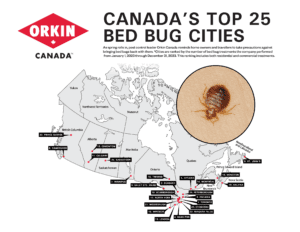Bed bugs are tiny pests, their average size being 3/16 inches (4-5 mm) long and their appearance being oval shaped, flat, and red to dark brown. Despite their size, they are still identifiable. These insects are classified as hematophagous, meaning that blood is their source of nutrition. Therefore, they are primarily nocturnal bugs, hiding in the daytime and coming out to feed at nighttime when humans and pets are asleep while remaining unnoticed. However, on rare occasions they will come out during the daytime to feed when a host is present. This occurs when bed bugs are hungry, have gone without feeding for a while, or are in public venues such as libraries or cinemas where humans do not spend nights. Physical signs of bed bugs include bite marks on legs, arms, neck, or face that are swollen or itchy.
“Contrary to popular belief, bed bugs are visible to the naked eye, but are excellent at hiding. Involving a trained professional to identify bed bugs that have been introduced or are in the early stages of an infestation is recommended,” Dr. Alice Sinia, a Ph.D. Entomologist at Orkin Canada, explains. “Bed bugs are extremely resilient, making them difficult to control. As people begin to ramp up their travel plans this year, it’s important they know how to protect themselves through pest identification and proper control.”
Check out Canada’s Top 25 Bed Bug Cities
Bed bugs are known for their rapid reproduction and long-term survival capabilities. These insects can produce one to five eggs a day, females laying from 200-500 eggs throughout their life, which can be from 4 months to almost a year. Bed bugs can survive for months at a time without a meal. It is crucial to take care of a bed bug problem as soon as it is spotted before an infestation occurs and it becomes a severe issue.
“While it’s important to be aware of bed bug infestations within hotels, practicing precautions in other aspects of travel are also important,” explains Sinia. “Taxis, buses, trains, and airplanes are also common bed bug hiding places, allowing these pests an opportunity to hitch a ride with unsuspecting travelers. Examining clothing and luggage regularly while traveling can help prevent introducing bed bugs into your home or business, helping you stop a future infestation from occurring.”
A case of bed bugs can occur when you least expect it, but they can be difficult to spot and get rid of. We have compiled a list of tips from the Orkin Pro on how to identify and prevent these pests:
For Homeowners:
- Be sure to check your home for signs of bed bugs frequently. In bedrooms or sleeping areas, bed bug hot zones such as mattresses, behind baseboards, nightstands and accessories, underneath picture frames, and on soft furniture, should be examined. In living rooms, the couches or sitting areas must be the focus. It is a good idea to do an inspection after having guests in your home or visiting elsewhere. This can include service workers, friends spending the night, or after a vacation. You can also add an extra layer of monitoring by installing bed bug monitors; these are available from professional pest control companies or over the counter in stores.
- Declutter your space. The less cluttered your home is, the easier it will be to search for bed bugs, whether on your own or for a K9 bed bug inspector.
- When bringing secondhand furniture into your home, thoroughly inspect it for any dark ink-like blot marks, whitish eggs clusters which are visible, bed bug cast skins, or bed bugs to ensure a pest introduction does not occur.
For Travellers:
Bed bugs are extremely efficient hitch hikers. They can move easily across a room and climb onto baggage, or anything left on a bed in just one night. Below are some tips you may consider while travelling (see more for Bed Bug Prevention Tips When Travelling).
Some things you can do to reduce the risk of picking up bed bugs as you travel include:
- Do not put your clothing or luggage directly on the bed. If bed bugs are present within the bed, they can climb into bags, suitcases or any laundry left on top.
- Always use metal luggage racks. Bed bugs cannot easily climb metal surfaces, so they make an ideal overnight spot for your suitcase. Keep the rack away from the walls and any wooden furniture.
- Use suitcase/bag protector plastic bags. These bags are specially designed to encase a suitcase, luggage, or carry on, hence protecting them from hitchhiking bed bugs. The protector can be inserted prior to travelling or upon reaching the hotel. Once in the hotel room, insert the suitcase in the protector bag, making sure the suitcase is tightly zipped. This should keep your personal items safe from any bed bug invasion.
- Use small, untorn plastic bags to pack clothing, shoes and other personal items. This will help prevent any bed bugs that climb into your suitcase from getting into your home via your clothing. Bed bugs can also hide or hitchhike inside books, cloth toiletry kits and other non-metal personal items including electronics, such as cellphones, laptops and even headphones.
- Hotels aren’t the only bed bug travel threats. Bed bugs thrive in dark, cool places with long-term access to humans. Therefore, they can be found on airplane and train seats, buses, or in rental cars. It’s rare but it is possible to pick up bed bugs in places like these.
- When you get home, vacuum your travel suitcase or bags promptly, using the crack and crevice tip of your home vacuum. Clean both the inside and outside of your suitcases thoroughly. Dispose of the vacuum bag or empty the canister in an outside garbage receptacle.
To ensure your next trip stays bed bug free, here are a few quick and easy ways to check for bed bugs:
- Survey your hotel room, searching for any symptoms of bed bug presence. You should keep an eye out for small red stains on the bed sheets. All courtesy bedding, including the mattress, pillowcases, and soft furniture should be examined for extra precaution.
- Lift and search underneath typical bed bug hiding zones. This includes: the mattress and box spring on the beds, furniture such as couches and soft chairs, and behind wall coverings including baseboards, hanging photographs, and tears in the wallpaper.
- Elevate your baggage to a safe zone. Placing your luggage and carry-on bags away from the bed or wall will help prevent any potential insects from entering your personal items. Placing them on counters or in the bathroom tub is the best thing to do.
- Examine your personal items. Your luggage should be examined before you leave and once you re-enter your home after a vacation.
- Place your clothing in the dryer. For the most effective precaution, run the drier for 20-45 minutes at its highest setting to get rid of any potential pests you may have carried into your home.
Remembering the acronym S.L.E.E.P will help you refresh your memory when it comes to following through with a bed bug inspection!
Check out Canada’s Top 25 Bed Bug Cities (click to download):
You may also like
Canada's Top 25 Bed Bug Cities Of 2022
Bed bugs are extremely efficient hitch hikers. They can move easily across a room and climb onto luggage or anything left on a bed in just one night. Learn which cities have made Canada’s top 25 bed buggiest cities.
Bugs & Kisses: Tips To Keep Pests Out Of Your Valentine's Day
Valentine’s Day is a holiday that’s all about spreading love and kindness. Unfortunately, the sweetness of this tradition also makes it an opportunity to attract and harbour pests, which can lead to serious pest infestations. If love is in the air at your property this year, it is important to take precautions against the various pests that intend to intrude on your plans. Whether you’re celebrating love day with family, friends, or a significant other, the gathering and gift giving traditions that go hand-in-hand with Valentine’s Day increase the probability of pests reaching you or your home. To help you avoid insects spoiling your romance, we’ve provided you with some tips on how to have a pest-free Valentine’s Day.
Who Invited That Pest? Tips To Avoid Pest Infestation At Your Next Party
Everyone loves a good party, but so do pests. For those looking to host a successful party, it is important to be aware of the possibility of having some uninvited guests…we mean pests. Whether you're hosting a Super Bowl party, throwing a birthday bash, or enjoying a night in with friends, remember that pests are popular party favours that may be left behind. While there’s not much you can do to prevent these pests from entering your home via your guests, you can take precautions to nip the problem at the source and avoid an infestation. To make it easier for you, we’ve put together a few tips to make sure your party stays pest-free.
Top 7 Pests Predicted To Trend In 2022
From mosquitoes and wildlife to ticks and flies, being prepared for spring and summer pests can have an impact on how enjoyable your time outdoors will be. Do not worry you are not alone, as the experienced team at Orkin Canada is there to help you prepare. After doing thorough research, we have put together a comprehensive list on the top 7 pests expected to trend in the summer of 2022. This list will provide an in-depth look at the impact that pests will have on your home or business, along with also providing easy to use preventative tips.
Remove pests from your home, and stop them from coming back
We work hard to listen, understand and assess your unique situation. Request a free, no-obligation estimate today for a customized pest program that fits your needs.
Request a Free Home EstimateRequest a Free Business Consultation


